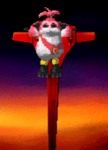 Add Review
Add Review Subscribe
Subscribe Nominate
Nominate Submit Media
Submit Media RSS
RSS
A hundred great ideas that almost entirely cancel each other out.
 The Real Brickroad
The Real Brickroad- 06/23/2009 10:37 PM
- 4321 views
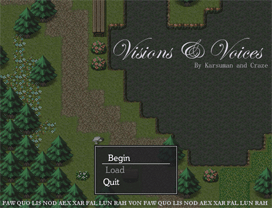
Title: Visions & Voices
Program: RPG Maker VX
Creators: Craze and Karsuman
Sample Time: five hours and change
~~~
Our Heroes
The hero of Visions & Voices doesn't have a name. Or he has too many names, and can't decide on one. In any case the game asked me what it should call him, and I said "HAMBONE." HAMBONE then wondered what his job should be, and I said "Sniper". And then he asked me how hard the game should be, and I said "Easy". HAMBONE has a cape and a turban, and there's some other stuff to say about him, but let's get the rest of the cast out of the way first.
Telia is an ex(?)-girlfriend of HAMBONE's who just happens to be nearby when he gets his quest underway. She's equal parts bard and nymphomaniac, and is as lovable as she is insufferable. Her dialogue is a bit much at times but overall she's a perfectly servicable sidekick character.
After a couple days HAMBONE meets Ox, the oafish farmhand. Ox is big, brawny, and friendly, and overall was probably my favorite character. He joins the party in order to search for his missing lady friend Lyla, a chilly man-hating priestess who has managed to get herself disappeared.
The last character I found was Dison, a crazed elderly gentlemen who cooks elaborate dishes from monster drops. I got a kick out of Dison whenever he opened his mouth, but by the time I recruited him my team was already pretty well-developed, so I let him sit on the back burner.
V&V is pretty open-ended about your party. Telia joins right in the intro, but you can turn down her offer if you want. If you do she really-for-real goes away. Not recruiting the rest of the heroes would be as easy as not speaking to them, I imagine. I'm betting there are some characters I missed over the course of the game, too.
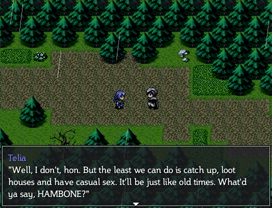
"I say this is the best goddamn RPGMaker game I've ever played. Bend over."
The party's home base is the Ogre's Mug Tavern in the center of the game world. While in the Ogre's Mug HAMBONE can strike up lengthy conversations with his companions, and each of them get a fair bit of characterization. HAMBONE learns about one character's sad and sordid past, discusses literature with another, and of course has nothing but contempt and mockery for Telia. By the time I was done with V&V I had a very clear image of each of the characters... except HAMBONE himself.
See, because of the open structure of V&V's party system, there aren't really any cutscenes or dialogue marathons. What you know about each character is limited to what they talked about when you first met and what they talk about at the Ogre's Mug. HAMBONE has things to say during these conversations, of course, but he more often than not tends to act as a reflection for his ally rather than a character in his own right. The HAMBONE you get when speaking with Telia is different from the HAMBONE you get when speaking with Lyla. It was strange getting to the end of the game and realizing I was better acquainted with my companions than I was with the main hero, but on the other hand it didn't work against the game either. It's just a thing that I noticed.
~~~
Eye Candy
The graphics were fine and the tilesets were competently handled. The monsters look a bit out-of-place alongside the rest of the battle graphics, but I only noticed that because the rest of the game looked so consistent.
The game only has one location: a village being overrun by... um... something. The village itself is comprised of several very, very large maps, all of which look more or less the same. The size of the village coupled with the relative lack of landmarks makes the game world seem very same-y, and it can be difficult to tell where things are in relation to each other. It's tricky to tell where you've been and where you haven't, and it's easy to see two paths during your travels, take the first and forget the second exists. In a game where you're expected to cover the same ground multiple times this can get disorienting quickly. I never really felt I understood how the village fit together beyond "the tavern is in the bottomleft somewhere, and there's a lake with some houses around it". I kept getting the sensation that I should be checking some nonexistent map.
That's it, that's the solution: in in-game map would fix this problem perfectly. Or an Ultima-style cloth map packed in with the .rar file. Whichever's easier.
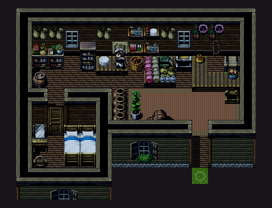
Dancing on tables: HAMBONE's secret passion.
There were two things I really, really appreciated as far as graphics were concerned. First, V&V clearly marks where the teleport events are with a shimmering circle, so you never have to hunt for the exit to an area. No running along the length of a map in search of that one magic tile that will take you over to the adjacent map -- it's clearly marked. This solves the problem a lot of RM games have when maps get too large or too busy because it becomes impossible to miss an area. If you touch all the shimmering circles, you'll see the entire game.
Second, I like the identical battle animations that occur before a spell comes out. Remember in the oldschool Final Fantasy games how a character would be engulfed in a different casting animation depending on what type of magic they were using? V&V does this with big, flashy color-coded sigils that let you immediately recognize what type of spell is being cast. The pre-casting animation is a bit long, it took me a few battles before I realized it wasn't an effect animation in and of itself, but once I got the hang of it I recognized it as a nice little bit of spit-shine. Nice work.
There's a third feature I kinda sorta didn't appreciate. V&V has a lot of different status effects, and these are applied mid-battle by actual pop-up text boxes saying exactly what status effect is being applied. The good side of this coin is that you don't have the memorize a whole set of status icons (although that helps). The bad side is that given the janky nature of VX's battle system, even in this modified state, it's tricky to tell exactly which character this text box applies to. Quick, a box appears that says "POISONED!" Does it apply to the person near the top-right corner or the bottom-right corner? It's hard to tell at a moment's notice.
The game does overlay a status effect icon on top of the character's name in the status window, but the icons are imperfect and don't convey a great deal of information unless you spend a lot of time with them. And as I sayd, there are a lot of status effects. It's not uncommon to see a star, a little running stick figure, a ring of light and a few miscellaneous blobs and baubles on top of every character in the group.
A fourth feature I am torn on: ATB bars for enemies. On one hand I like having this information. In practice it is the next best thing to a turn order indicator. However, a monster's ATB bar stays onscreen even after you kill it, which just clutters up the battlefield. This isn't a major gripe, but it nagged at me continually as I played the game so I feel it's worth mentioning.
~~~
Ear Candy
The music didn't make much of an impression on me. There were several battle themes, which is interesting, but they seemed to be applied haphazardly and not by region or difficulty. I can't say this is a bad thing; you spend so much time in V&V fighting monsters that it's probably for the best you aren't listening to the same combat music hour after hour. It just seems like the designers missed an opportunity here to marry their music choices with the gameplay.
The variation found in the battle music doesn't carry over to the game's maps. If you're in the village -- anywhere in the village -- you're listening to some gloomy, somber music and if you don't like it tough. This is true even inside the tavern where your party is hanging out. I understand that the village is haunted (or whatever) but the depressing music really got to me after a while.
When you finally find your way into a dungeon area, the change in music is going to knock you flat. Dungeon music is so upbeat and high-energy that you'll be wondering where the fire is. I supposed stepping into a cave after spending an hour or so running around the village is exciting, but I'm not sure the adrenaline needs to be pumping that much.
~~~
Storytelling
V&V is one of those rare games that has writing but no story. As mentioned above the cast is pretty open-ended, and the game is designed to be won (I think) with a solo character if that's what you're really into. Nonetheless I never felt like my party was patched together. They felt coherent, and I knew a great deal about each of them. Just wandering around the village and poking into people's stuff you get a pretty good sense of the place you're in. Each new day brings a new conversation with each of your party members, each of which has their own unique voice and their own unique interaction with the hero. The writing is great.
What's missing are events. The setting, the sense of, "well, here I am" is finely tuned. But nothing happens. You meet a person on one day, and the next day that person isn't there. Another person talks about a problem he has, but there doesn't seem to be any way to resolve it. When you gain access to a new area in the game it isn't because you figured something out or made something happen, it's because some arbitrary length of time has passed and the game decided to let you into a new area.
Now's as good a time as any to come clean and admit I didn't finish V&V. At least, not in the real sense of "finish" where one plays a game and sees its story through to completion. In fact, after five hours of play I believe I have my game saved in an unwinnable state. I've found scraps of what might point towards a story somewhere in the game world, but they're too easy to miss. They barely exist. They reference a character I've never met, doing something I can't comprehend, witnessing events that I didn't see. The things that happen in the game world happen offscreen, while the heroes are in another part of town. The pacing is, "here you are in the creepy village. Somewhere, there might be a plot. Maybe you'll find it, maybe you won't. We'll see."
It's a difficult judgment to make. On one hand it really did frustrate me, constantly. Another day, another walk around town. For what? There's nobody new to talk to, and the old people just say the same things. Anything I find will be there because it's a New Day, not because I had some impact on the game world. There's never even any indication on where those New Things might be, or what they are, or why. I was constantly swimming, directionless, and without a compass. No way to orient myself and, even if there were, no real motive to push forward.
On the other hand, what is the alternative? Forced cutscenes? Lengthy journal pages? Is a door that unlocks because I talked to its owner and learned something about him really less arbitrary than a door that unlocks "just because"? I don't think for a moment V&V's gameplay would have been made better if there were a plot. Story is not the focus of the game and I have a hard time faulting it for that. The solution to being lost in the geography of the world is easy: put in a map. The solution to being lost in the game's plot is... not so obvious.
As it turns out, my experience is probably not typical. I did find a clue, very early on, but interpreted it as merely a piece of background information rather than a clue. Hours later I stumbled upon a second clue, which caused me to take another look at the first, and see the connection between the two. Then I found three more clues in short order, which seemed to put me on track of the plot I was vainly searching for. Of course by that time it was too late; as I said, the game was already in an unwinnable state by then. And the clues I followed, the minor bits of plot I did find, they didn't fit with the rest of the game I had been playing. I didn't learn anything, and I'm still not sure I ever would have. It was like, okay, the game is in this column and the story is in this column, and never the two shall meet. That's pretty standard for gameplay-heavy RPGs, I suppose.
Returning briefly to the subject of the writing, I did like how my party members would chime in with little quips at random places in the game world, even as just a helpful reminder that they were still there. The characterization was nice, but the implementation was slightly bugged; at one point the game recognized a character I had never met as "in my party" and had him helpfully advise me against falling off a narrow ledge. At another the same character's quip would repeat the same way, every time I entered that map. Both instances pulled me out of the game a bit.
~~~
Gameplay
Dig in, guys. There's a lot to cover here.
Let's start with my very first experience with the game. HAMBONE asked me to set a difficulty level. I had been informed that V&V was a pretty short game, maybe five or six hours, so I figured I'd play on Easy and, if I really liked it, try a harder level after I learned some things. Then the first character, Telia, offered to join my party. I turned her down, expecting it to be a Dragon Quest-style "but thou must!" situation. It wasn't, which struck me as odd. "Okay," I said, "I missed that party member. But the game's only five or six hours long, surely there's replay value here. No biggie." Then I set out in search of a save point, so I could explore the world on my own terms. I got into a battle and very narrowly won, showing me just how dangerous it was to run around the game world by myself. By now I really needed a save point, but before I found one I got locked down with some uncurable status ailment and died.
No way to revert to my last save, since I hadn't had the opportunity to make one yet. Back to the intro with me! I was pretty mad. Remember, I had picked Easy. I'm all for a game with a high difficulty level, but something's not right when the player can screw himself so early and so thoroughly as I did before he even gets his bearings on the easiest difficulty setting. I restarted, picking Easy again and this time accepting Telia's help. Then I started playing the game for real.
What I discovered was: V&V has some great gameplay ideas. A lot of them, in fact. With one exception, though, they are all implemented poorly. Well, that's not fair. The implementation of some of them is fine, and only hampered by the implementation of others, which in and of themselves are fine except for the implementation of others. It's like a bunch of great ideas squared off and charged at each other only to butt heads and knock each other unconscious.
I mentioned one exception, so I'll start there: Feats. Every character (except HAMBONE) has a special function they can perform in the game world. Ox can forage for herbs, Telia can open boxes without keys, Dison can cook food, and so on. Each game day your collective party can use a set number of Feats. So when it's just HAMBONE and Telia running around, the decision is easy: use a Feat instead of wasting a key on a door. When you have more characters, you have to start budgeting them a little more intelligently and make some judgment calls about what the party needs versus what resources they have available. If there are characters with totally useless Feats, I didn't meet them. The idea is good and the implementation was good too. Everyone should steal this idea, forever. Thumbs way up.
As for the stuff that didn't work, in other words Everything Else, let's break that up into combat and non-combat situations. There is nothing good to say about combat in V&V. Absolutely everything about battles set me on edge. Oy vey.
V&V has on-touch encounters on the game map. That's good! Everyone got sick of random encounters in 1990. V&V also lacks an EXP system; battles don't advance the party's power level in any way. That's also good! Everyone got sick of grinding for EXP a couple years before they got sick of random encounters. The combination of these two concepts, though, means that fighting is completely pointless. There's no reason to ever do it. You avoid every monster on the map, except the one that is placed directly in the way of the stairway or treasure box you're trying to reach. Avoiding monsters is either impossible or trivial; you fight the impossible-to-dodge ones and dodge everything else. Since your characters don't get stronger from combat there's zero incentive to fight those easy-to-dodge battles, and since your characters can pick and choose what they want to fight they can usually go into each combat at full power. The player is never in a position where he has to decide to fight the monster in front of him or not; it's instantly apparent what the optimal decision is.
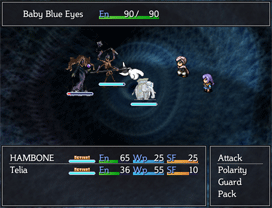
A black witch, a zombie juggler and a tiny elephant named Baby Blue Eyes. Makes sense to me!
I did mention earlier that you spend a lot of time fighting in V&V, so it might sound like I just contradicted myself. I didn't. You don't fight a large quantity of battles, but the fights you do land in take a very, very long time. I quite frequently found myself in situations where my strongest hero could dish out, say, 15 damage against monsters that had 90 HP. And there'd be four or five monsters in the fight. Every time I saw a monster in a map guarding a treasure box, I sighed and got out my little chisel and hammer, then hunkered down to chip away at a stone wall.
Each hero has several combat abilities which are driven by two different types of MP. (The game calls these "Willpower" and "Sheer Force", but they're really "MP" and "Other, Slightly Differently Colored MP". Also I think "Sheer Force" is probably the dorkiest name I've ever seen given to a stat in an RPG, and I've played an RPG with a Moustache stat.) In most situations these abilities are almost completely useless. There are, as far as I can tell, no true direct damage spells. HAMBONE had a spell that did a little less damage than he could do attacking, but lowered the enemy's elemental resistance. Telia had an ability that lets a character regenerate some health over the course of the battle, which was neat but still left her with not much to do. The ability descriptions were incredibly vague, and even after some experimentation I still never figured out what many of the other abilities did. It's possible there's a rich patchwork of combat decisions here which play off one another, setting V&V aside from "damage/heal/revive" style combat, but the game didn't seem to want me to find it.
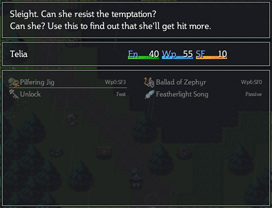
Can you guess what this ability does? If you said "steals gold from monsters" then, congratulations! You're one of the two guys who made Visions & Voices!
Each character had a "passive" ability that stayed greyed out the entire length of the game. I have no idea what these are or how to activate them. The readme dances around them a bit, but I have no idea what it's saying, either. Oh well.
Status effects play a major role in V&V, as I've stated before. Not just on the heroes, either; many of your abilities and weapons will inflict them upon enemies as well. Lacking, though, is a solid explanation of what these various effects do. Enemies the game told me were "bewitched" didn't seem to act any differently or die any easier than enemies who were not. I think I can make a guess as to what "Enfeebled", "Brawny" and "Insane" meant, but I can't really be sure. The effect I liked most was poison, because it was easy to inflict and gave strong feedback when it worked.
The number one problem in the battles, though, is dealing damage. There are many different types of weapons in the game, each tied to one of the five core stats -- or so the help menu says. In practice I didn't see much correlation between weapon types and the stats that were supposed to make them effective. I struggled the entire game to get Telia to be able to deal damage. Her regular attack was pitiful, but it took way, way too long for HAMBONE to kill everything himself so I sat down and got thinky. The in-game help menu says that "Psychic" weapons are enhanced by "Charisma" and that "Ranged" weapons are enhanced by "Perception". Well, HAMBONE was doing really good damage with a ranged weapon, and Perception was his highest stat, so I figured all Telia needed was a Psychic weapon to go along with her high Charisma and she'd be set. So I trudged out to the swamp witch and bought her a Psychic stick, only to watch her damage output drop by four or five points. The next day I found a new weapon for HAMBONE and gave Telia his leftover bow, and her attack went higher than what it started as even though she had a much lower Perception.
Huh? Am I supposed to correlate a character's stats with their weapon choices, or aren't I?
It's possible (and fitting with standard RPG convention) that each individual weapon has its own attack power, but this is not reflected in any way on any of the in-game menus. If Psychic Stick A is stronger than Psychic Stick B, the only way to tell would be to experiment with each one. Which means equipping A, getting into a fight, trying it, then equipping B, getting into another fight, and trying that. But wait -- this is a game where you're not supposed to fight a lot of battles! Experimenting with weapons means using resources, which are at a premium. You can't help yourself without hurting yourself, and this is assuming that "attack power" is a hidden stat in the game to begin with.
I never did find anything that let Telia do any damage, although she consistently did better with Ranged weapons than Psychic ones. This flies in the face of what the readme and the in-game help tells you, so I don't know. I had varying success with other characters, but I never reached any level of understanding beyond "this weapon does more damage than that one and I have no idea why".
Two more notes on combat, one about escaping and another about monster types. Escape is virtually impossible. If you try and fail (which happens almost every time) your characters' ATB bars all bottom out, giving every monster a couple free shots on you. It's not really a viable method of saving yourself if you're in trouble, and it's not really a viable method of getting out of boring battles you don't want to fight, either. Either let me attempt to Escape individually with each character or let me attempt continuously without penalty. Final Fantasy got one method right in 1991 and RPGMaker got the other one right in 2003. No need to re-invent the wheel, here.
There are way, way too many monster types. There's no real sense of environment in V&V; you'll fight birds underground and fish on dry land, usually several types of monsters in each battle and different groups of monsters in each area. I liked the abstractness of the encounters, I liked the goofy monster names, but I feel like in a game where combat is this deliberate I should be learning more about each individual monster than I was. When you see twelve different types of creatures across two screens, it's difficult to keep them all in your head and devise combat strategies for each one. Much easier to just fall back on the old standby of "attack, then attack, then attack, until you win". It's boring, but it works.
Wait, I just thought of one more combat thing: healing items only affect the characters that use them. You can't, say, have HAMBONE use an Energy Shot on Telia. If Telia is low on HP, she has to select the Energy Shot herself. This is fine, but I wish I'd known that without wasting an Energy Shot and having Telia die as a result.
Now I'm going to do something horrible: I'm going to spoil V&V's biggest gameplay twist. I apologize, but you'll like the game more if you go in knowing this. The game is timed. Each time you spend the night at the inn you advance one day. You have a set number of days to explore the world and learn... whatever it is you've set out to learn. If you don't accomplish everything in that time period, the game ends. The Dark Spirits of Whatever come and eat your mind and soul, and if you're not satisfied with that you start the game over from the beginning.
Going in, I did not know the game was timed. I had this great big village to explore, and I thought I could explore it at my liesure. New areas randomly opened up, new characters joined my team, I found stronger gear and toppled a couple really powerful monsters. Then I went to the inn and got the bad ending. I lost before I even knew there was a way to win.
So now that you know that, let's talk a bit about the structure of the game. A lot of V&V is spent exploring the village the game is set in. The village and its surrounding environment is huge. It took me about an hour to cover it all. I enjoyed poking around the various areas, finding the graveyard and the bog witch that sells weapons, discovering the tavern and its function, stockpiling items and resources. Eventually there wasn't much to do and I was starting to get weak from fighting, so I slept at the inn. A new day dawned.
I did not enjoy my second time running around the village. The game state had not changed. I didn't discover anything new. I had this nagging feeling I was missing something important, but there was not only no way to find out what, there was no way to find out how I could find out what. Eventually I started getting weak from fighting, so I slept at the inn. A new day dawned.
After a couple days of this, I noticed a mirror was glowing. I touched it and... it teleported me to a dungeon. Wait, what?
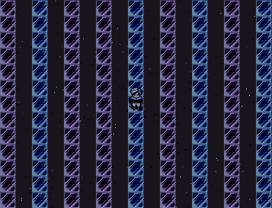
At least said dungeon had some exquisite mapwork!
This happened completely at random, and I still have no idea why it happened or what I did (if anything) to make it happen). I was glad it happened, though, because it gave me New Stuff to do. I ran around town looking for mirrors, each one yeilding new territory and a few treasures. I stumbled upon a minor subplot involving two of my party members. But, within a day of exploring, I had run out of mirrors. And eventually I started getting weak from fighting, so I slept at the inn. A new day dawned.
A day or two later other random objects in town started glowing, which started transporting me to other random dungeons. I was, again, glad for this. New territory! Woo! But I don't know the underlying reason for what happened, or how I could have made it happen earlier, or what implications it had on me or the game world. I ran around touching all the glowy things and before long I had been through all the dungeons. Eventually I started getting weak from fighting, so I slept at the inn. A new day dawned.
This process of re-explore the entire game world in search for the new glowy object, then explore the new dungeon for no reason other than it is there, continued until, one night, a new day didn't dawn. Evil Spirits ate my soul. Game over. Better luck next time.
I'll mop up with a couple of mechanical notes about the non-combat aspects of gameplay. There's no autorun option, although there should be. You naturally want to run everywhere, except when in the vicinity of monsters when you want to sneak. So the default should be run, but with a sneak option if you want it, not the other way around.
It's obnoxious to have to open my menu to see how many of each type of key I have. When I click on a chest and it says "You need a Typical Key" it should also tell me how many Typical Keys are in my inventory. Oh, and there's a hard cap on items; you can only have nine of each type. This means that you're going to lose a ton of items to the void when you, say, pick up five keys but are already holding nine. I started running out of keys very late in the game and couldn't help but grumbled about all the keys I had wasted because my pockets weren't big enough. Either let me hold more keys or don't automatically discard ones I can't carry.
Alphonse seemed to have a subquest for me, but I couldn't find a way to resolve it even after scouring the entire game world multiple times. I have no idea what the deal there was.
~~~
Bugs! Bugs!
Some of the grammar was weird. You'll see things like "Rumormonger had a Opal!" and "Grapes was found!"
When you open a treasure box the window that opens up telling you what you found autocloses after a couple seconds but doesn't freeze your movement or other actions. So I spent the entire game -- and I mean the entire game -- habitually hitting the button to try and make the treasure window go away, and instead causing HAMBONE to re-examine the treasure box. Every single box in the game helpfully informed me that it was now empty.
Some teleport events don't work properly. The road outside the village seems to wrap around itself, and there was one spot in the pink cave dungeon where the stairs up to the village didn't work. The third time I accidentially went down into that area and realized I was two or three forced combats away from the next nearest exit since the one I just came in was broken I about gnawed my arms off.
At one point after Ox and Lyla joined my party I triggered a cutscene outside of Ox's farm where he joined the party a second time, causing all of his equipment and his Frenzy ability -- one of the few combat skills I was actually getting some use out of -- to disappear. This happened fairly late in the game and my new Bizzaro-Ox was never quite as powerful as my old Ox, so I was pretty irritated about that.
~~~
Why I Quit
There were two doors in the game world I couldn't open with the keys I had. I eventually found a way to open one, but by the time I finally found that plot thread I had eaten up too many days and there was no way to avoid the bad ending. I was so sick of the broken and boring combat that the prospect of starting the game over from the beginning, even with all the knowledge I had accumulated, was too painful to entertain. The bad ending of V&V will have to do.
~~~
As Seen From Space
Visions and Voices is, ultimately, a collection of very interesting gameplay ideas that is absolutely crippled by its three-week development time. The designers took this dish out of the oven before it was done cooking. These are ideas that I not only want to see polished here in V&V; I want to see them used in other games as well. Nothing here works, but its not the individual parts that are broken. The machine is just not receiving power, or is receiving too much, or is using the wrong kind of A/C adaptor. An excellent game resides within, trying to claw its way out.
~~~
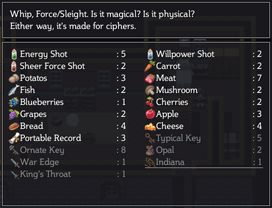
This one reference makes up for every single negative thing I had to say about V&V.
"Well, of course, sir! You especially like my thigh pies." - Dison, Visions & Voices

Posts 

Pages:
1
I'm not a terrible active member here, but I have been following your stuff. You write terrific reviews, Brickroad. Keep up the good work.
There is the same kind of disagreement between review text and review score here that you get with magazines like Game Informer. I feel like given the review text, the score should be perhaps a full point lower. But this was an excellent review and articulated exactly how I felt (about the battles, at least) probably better than I could have.
Brick admits that he scores relatively randomly/how he feels at the time.
Or maybe he just likes the ideas a lot, despite faulty execution.
Or maybe he just likes the ideas a lot, despite faulty execution.
Pages:
1











